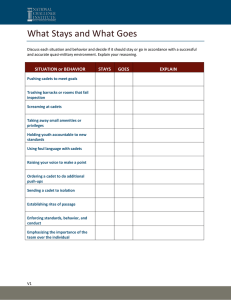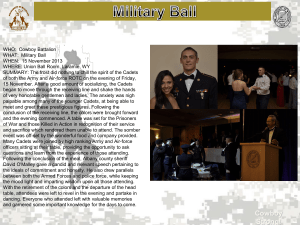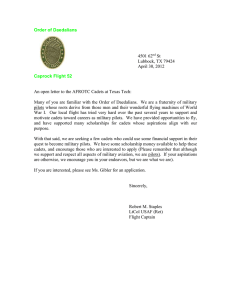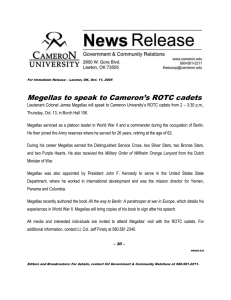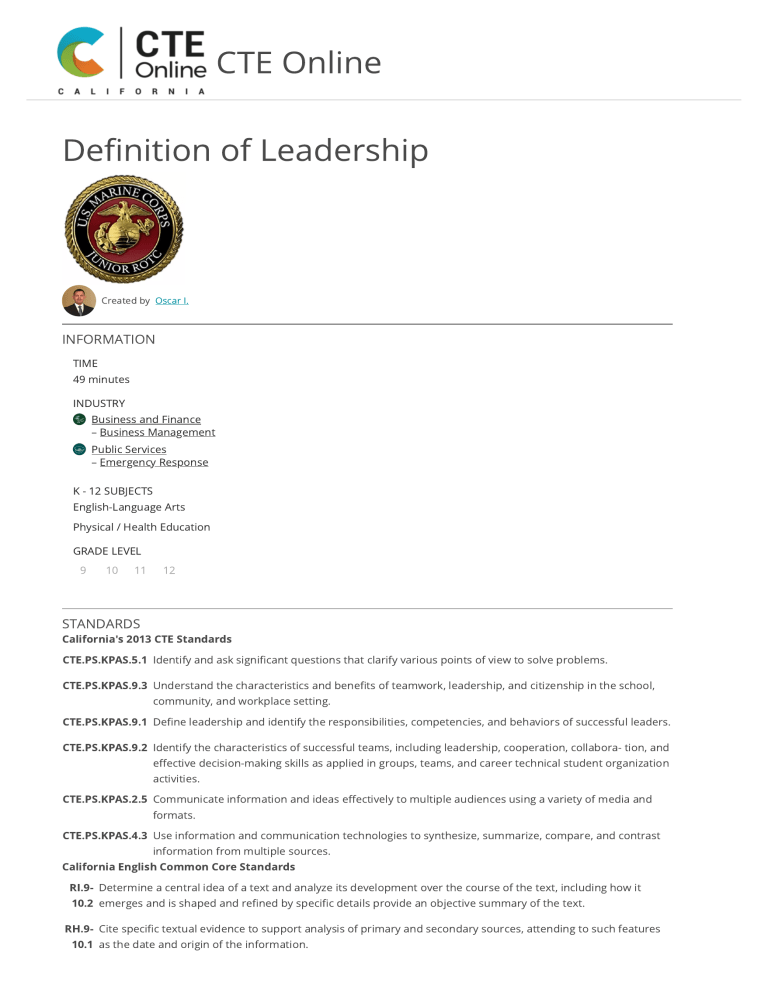
CTE Online Definition of Leadership Created by Oscar I. INFORMATION TIME 49 minutes INDUSTRY Business and Finance – Business Management Public Services – Emergency Response K - 12 SUBJECTS English-Language Arts Physical / Health Education GRADE LEVEL 9 10 11 12 STANDARDS California's 2013 CTE Standards CTE.PS.KPAS.5.1 Identify and ask significant questions that clarify various points of view to solve problems. CTE.PS.KPAS.9.3 Understand the characteristics and benefits of teamwork, leadership, and citizenship in the school, community, and workplace setting. CTE.PS.KPAS.9.1 Define leadership and identify the responsibilities, competencies, and behaviors of successful leaders. CTE.PS.KPAS.9.2 Identify the characteristics of successful teams, including leadership, cooperation, collabora- tion, and effective decision-making skills as applied in groups, teams, and career technical student organization activities. CTE.PS.KPAS.2.5 Communicate information and ideas effectively to multiple audiences using a variety of media and formats. CTE.PS.KPAS.4.3 Use information and communication technologies to synthesize, summarize, compare, and contrast information from multiple sources. California English Common Core Standards RI.9- Determine a central idea of a text and analyze its development over the course of the text, including how it 10.2 emerges and is shaped and refined by specific details provide an objective summary of the text. RH.9- Cite specific textual evidence to support analysis of primary and secondary sources, attending to such features 10.1 as the date and origin of the information. SL.11- Plan and deliver a reflective narrative that: explores the significance of a personal experience, event, or concern 12.4a uses sensory language to convey a vivid picture includes appropriate narrative techniques (e.g., dialogue, pacing, description) and draws comparisons between the specific incident and broader themes. (11th or 12th grade) Introduction This lesson explores the Marine Corps definition of leadership. Learning good leadership skills and becoming a successful leader are not easy tasks. With this introduction to leadership, you can begin to appreciate the characteristics that successful leaders exhibit to themselves, their team members, their supervisors, and their organization. Objectives After completing this lesson, cadets will be able to explain the Marine Corps definition of leadership. Cadets will be able to understand how influencing others is a key aspect of leadership. Cadets will be able to explain the three aspects of leadership: purpose, direction, and motivation. Activities in this Lesson Icebreaker: Hooks / Set In teams, cadets share their stories and experiences about a time when they were part of a team. They identify leadership behaviors exhibited and share their list with the class. Total time: 4 minutes Energizer: Group Work Form teams of 3-4 cadets. Identify a leader in each team. 1. Instruct the leaders that they may not talk to their team members. They can only communicate via hand gestures (no writing messages on paper). 2. Each leader is given a sheet of paper with 4 to 5 items on it. Leaders cannot show the list to their team members. Note: The lists can have the same items on them for all the teams or different items. An example of a leader’s list may be: chalk, pencil, student textbook, a photo from the chain of command, and a piece of loose-leaf paper. 3. Each leader must communicate without speaking to their team members. The team members must go and retrieve the items on the list. 4. The first team with all of their items retrieved from their list wins! Then ask cadets the following questions: • How effective were your leader's instructions? • How successful was your team in accomplishing the task? • What would you have done differently if you were the leader? Total time: 6 minutes Inquire Group Work Ask cadets to think of the following: • A time when they were part of a successful team, project, or activity of which they were proud. Examples include: community, school, sports, work, or JROTC. • The things the leader did that made that situation successful. Then form teams of 3 -4 cadets. 1. In their teams, have the cadets describe the situation or activity of which they were proud. 2. Designate a cadet to capture the discussed leader behaviors in a Sunshine Wheel graphic organizer. 3. Ask the teams to combine their lists by writing one complete list of behaviors on the board or chart paper. 4. Have cadets return to their teams and, based on the behaviors they identified, write a definition of what they think the definition of leadership is for Marine Corps JROTC. Total time: 8 minutes Gather Group Work 1. Inform cadets that they will remain in their teams. 2. Ask each team to think about the definition of leadership from the Inquire phase and how their definition compares/contrasts with the definition in the text. 3. In teams, ask cadets to read the first part of the student text (stop just before the topic “Organizational Structures”). Within their teams, assign the reading of the student text as follows: • Ask a cadet to volunteer to be the reader. • Assign each of the other cadets a specific topic to listen for in the text and write down the information they hear. These topics include: Purpose, Direction, and Motivation. 4. Next, each team reviews the class list of behaviors (identified in the Inquire phase) and discusses where they might fit into the definition of leadership. 5. Cadets create a double T-Chart with the headings of Purpose, Direction, and Motivation. Categorize each behavior listed on the board into one of the 3 categories on the T-Chart. 6. Arbitrarily ask 3 of the teams to come up to the board and fill in one column of the double T-Chart. 7. Clarify categories and discuss commonalities or differences in the categories of behaviors. Ask the class the following questions about the double T-Chart. • Where are there repeated behaviors across the categories? • Why do we see this crossover? • Did any of you put the behaviors into categories different from the way they are listed on the board? 8. Ask each team to review their team’s definition of leadership and modify it based on the additional information that they learned. Total time: 13 minutes Process Research / Annotate 1. Inform cadets that they will remain in their teams. 2. Tell cadets that they will be learning about people who exhibit leadership behaviors. As they learn about these behaviors, ask cadets to think about the leadership behaviors exhibited. Option 1: 1. Each team reads from the topic “Organizational Structures” through Case Studies 1-3 of the student text. 2. Next, arbitrarily assign one of the case studies to each team to develop a graphic organizer. 3. The teams create a Fishbone graphic organizer of the assigned case study that identifies the leadership behaviors exhibited by that leader. 4. For each of the 3 case studies, ask teams to volunteer to present their graphic organizer to the class. Option 2: 1. Ask each team to think of a well-known historical leader. Examples include: George Washington, Martin Luther King, John F. Kennedy, Abraham Lincoln, Napoleon, Eleanor Roosevelt, Susan B. Anthony, Mother Teresa, and Madame Curie. (Have research material available if possible, such as library books or Internet access). 2. Each team uses a Fishbone graphic organizer (see example above) to identify the leadership behaviors exhibited by their historical leader. 3. Each team should present their graphic organizer to the class without revealing who their leader is. Then, have the p g p g rest of the class try to guess the leader presented. g Total time: 10 minutes Apply Lecture 1. Ask cadets to individually read Case Study 4 and the remaining student text. 2. Using Visual 1, ask cadets to do the following in their notebooks: • Write the definition of leadership according to the student text. • Answer the following questions in your notebook: o What did you learn about how you influence others? o What are some leadership behaviors you would like to adopt? 3. Distribute Handout 1 to cadets for them to use as a reference guide. 4. Completion of a notebook entry answering the following: • What did you learn about leadership today? • If someone asked you to describe yourself as a leader, how would you respond? Total time: 8 minutes Assessment Assessment Type(s): Journal, Test / Exam Description Cadets read the final case study and complete a notebook entry. Cadets will be assessed by written exam. ABOUT CTE Online is brought to you by the Career and College Transition Division at the California Department of Education. Project management is provided by the Butte County Office of Education's CTE Center and CADRE.
